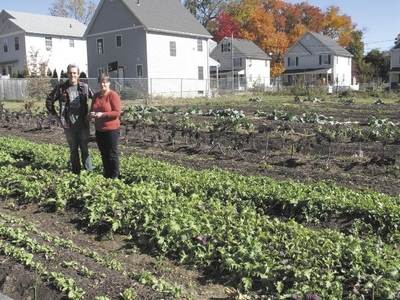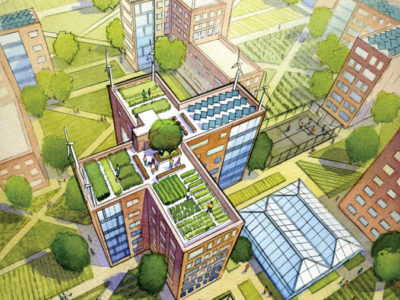More vacant parcels and derelict buildings across the country are returning to productive use as urban farms and other food-related enterprises, according to a recent report from PricewaterhouseCoopers and the Urban Land Institute.
It’s a movement evident in Hartford, too, from community gardens dotting city neighborhoods to veggies growing at onetime industrial locations like the former Swift Factory site in north Hartford, where plans call for a food-centered project to energize the economically challenged neighborhood.
“Are we likely to see barns and silos dotting our cityscapes?” reads the report, “Emerging Trends in Real Estate,” from PwC and ULI. “No, that is hardly the point. What is important — and trending — is the new vision that has urban land as that most precious and flexible of resources. The idea that the end of one productive use of a real estate asset spells the extinction of value and the sunsetting of opportunity is an idea whose time is over.”
Hartford has been at the forefront of encouraging urban farm use, according to Martha Page, executive director of Hartford Food System Inc., a nonprofit dedicated to finding long-term solutions for access to affordable, healthy food.
The city solidified that support in a zoning code change last April “to very specifically articulate support and parameters around both urban farming and community gardening,” Page said. “Our zoning code now supports this activity in a very forward-thinking way.”
Among Hartford Food System’s programs is Grow Hartford, which harvested more than 21,000 pounds of produce from its urban lots last year, with food going to many low-income households and community service organizations, and sold at the Hartford Food System’s North End Farmers Market and in its Hartford Mobile Market, a bus launched last December to bring healthy food to underserved neighborhoods year-round. The farms also serve as urban classrooms to educate the community about food and nutrition.
Urban farming is a good use of open space, Page said, noting that even asphalt lots can be farmed with raised planters.
“If somebody wants to build some wonderful tax-bearing [development] at the corner of Park and Main Street, I would have a hard time arguing that farming on the corner of Park and Main is a higher and better use,” she said, referring to the site of one of Grow Hartford’s four farms. “On the other hand, those [developments] take years to materialize and in the meantime, if the land is vacant, farm on it. If you’ve got people who want to farm it, as long as it’s feasible to do that, it is certainly a better use of land than just having it sit there vacant and I think it makes it more marketable in a way.”
Ed McMahon, senior resident fellow at ULI in Washington, D.C., said food is becoming a more important part of real estate development around the country, from rooftop gardens to edible landscaping, farm-focused housing developments, urban food markets in former industrial buildings and more. He outlined a dozen such projects recently featured at a national conference.
“I don’t think there’s any chance that this is going to replace agribusiness or large-scale commercial agriculture,” McMahon said. “Cities still need to think about preserving farmland on the urban edge. We’re not going to supply all the food needs of our cities just by rooftop farming and things like that, but what it does do is it takes derelict land and derelict buildings and gives them a new lease on life.”
Swift factory
A new life is envisioned for the Swift factory, a former gold leaf manufacturing facility on Love Lane in northeast Hartford, the city’s poorest neighborhood, plagued by high unemployment and higher rates of health problems.
Community Solutions, which took ownership of the 2.6-acre site in 2010, plans a project there, Made at Swift, that will be a “game-changer for Hartford and the Northeast neighborhood,” according to an executive summary of the project for the federal Strong Cities, Strong Communities Challenge for which the project was awarded $100,000. “The Made at Swift project is an example of how investment in the food sector can spur economic development on several different fronts.”



